Robotic Surgery: towards the "perfection"
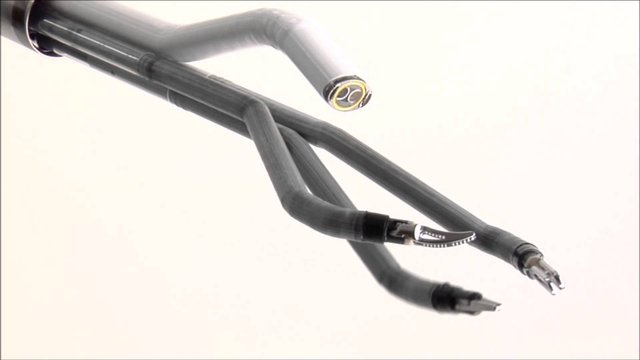
New robotic technologies will totally change the surgery procedures with huge impact on patients health. Credits: Intuitive Surgical. Authorized reuse.
Yesterday I was looking for some surgeon colleagues on @steemstem discord to exchange some opinion about my field of interest: surgery and robotic surgery. I didn't find any but I found lot of interested people in this topic...so I decided to describe the future of surgery in this post!
Every year, in Italy, all surgery society meets together to discuss new procedures, new technologies and set up their objectives for the upcoming year.
This event is called "Congresso Congiunto delle Società Scientifiche di Chirurgia" that can be translated with something like "Scientific Surgery Societies United Meeting": aside from the exact translation this event consists in almost all major italian scientific surgery societies joining together to spread scientific progress on medicine and surgery topics.
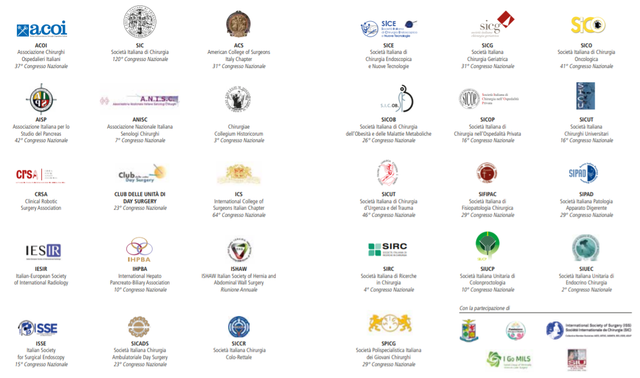
All the societies attending 2018 meeting. Image of my property.
Usually each scientific surgery society has its own field of expertise: the ISHAW field of expertise are hernia and abdominal wall surgery, SICCR is the society of colo-rectal surgery, and so on.
The event took place in Rome, in an huge meeting center called "Nuvola" (cloud, guess why) and lasted for 5 days.
 Meeting banner under the huge "cloudy" structure. Image of my property
Meeting banner under the huge "cloudy" structure. Image of my propertyWhile I learned a lot on different topics (there were more 15 classroom plus an auditorium, each one holding a different conference on a specific topic) there was one word that experts keep repeating for every surgery field. As a curious person that also fall in love with technology since I was a child, choosing medicine as career path was not so easy. Having both my greatest passion, medicine and technology, fused together, it's just a dream becoming true. You may have already found that word since this post title is self explanatory: the word people keep repeating in almost every conference room was robotic.
| What is Robotic Surgery? |
|---|
Robotic Surgery is a new technique of making surgery with a minimally-invasive approach that greatly improve some important outcomes like hospitalization time, infection rate, complication rate, bleed loss and wound healing compared to traditional surgery. Traditional surgery is also called "open surgery" because surgeon start with a large skin incision to open and expose the abdomen cavity: this is a really invasive procedure that it's currently used only in some specific situations (like emergency surgery or in some specific patients). Currently, the gold standard in surgery is the laparoscopic approach, another minimally invasive technique that has the limit of the 2d movement for the surgeon (surgeon moves instruments watching their position in the abdomen via an endoscopic camera: there is no depth dimension).
Robotic surgery take everything is best from open surgery and laparoscopic surgery while deleting bad aspects from both:
- It's a minimally invasive procedure, so no big skin incision and faster recovery for patient
- The camera is in very high resolution (Full hd and 3d HD) and has a great magnification, so the surgeon can see way more better the patient anatomy
- There is a depth perception, since everything is controlled by surgeon fingers that can move freely in the space
- The robotic arms have jointed wrist that can rotate in position that are impossible for human hands
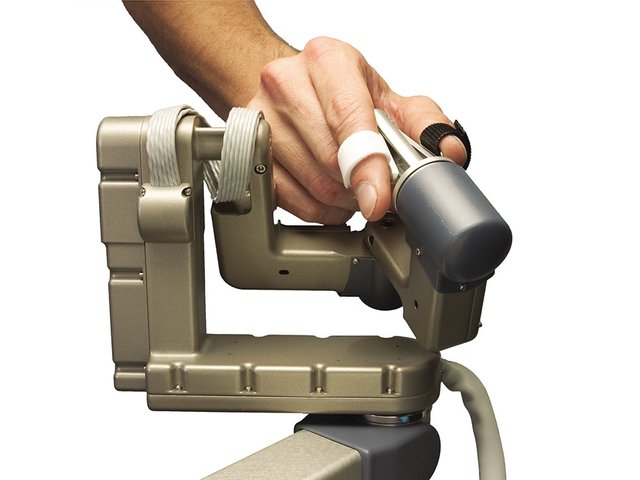
That's what you need to control robotic arms: two fingers. Closing fingers will close the pinch while moving or rotating the hand will move the instrument as if you are inside the patient. Credits: Intuitive Surgical. Authorized reuse.
During the meeting I had the chance to use a daVinci Xi for a brief time in a training exercise consisting in tie and untie paper clips to each other (lucky me!).
If I have to describe something that comes close to that experience, I would say Virtual Reality is pretty close. I had a magnified view of my training field and a total freedom of movement with hands. All movements were incredible fluent and I managed to complete a task that requires minutes with laparoscopic instruments (by an expert surgeon) in a bunch of seconds.
| Robotic Surgery: State of Art |
|---|
I will give just few numbers: if we type "robotic surgery" on the most important medical database pubmed we have less than 800 papers compared to the almost 7000 papers for the "laparoscopic surgery". This means robotic surgery is a new field of interest and it's still very young. The number of daVinci Surgical System installed (daVinci is the main robotic surgical system nowadays), is currently over 2,900 systems in the U.S. and over 4,500 globally. According to the Intuitive Surgical (the company behind daVinci robots) the use of the robotic system increased by 13% in the US and over 23% in Europe. These numbers are really important because the main critique to the Robotic System is its limited field of use. In fact, since few years ago, robotic systems were used mainly in urological surgery for their extreme precision, allowing an higher success rate in nerve-sparing procedures with a decrease in post-operative complication rate for these patients. Now, these robotic system are used for almost any procedure: in 2016 there was an increment by 36% for the use of robotic systems in general surgery. Currently daVinci and robotics surgery in general has its field of operation extended to cardiac surgery, general surgery, gynecologic surgery, head & neck surgery, thoracic Surgery and even transplants. The main drawback of this systems are costs: while in the US there is little difference in costs for the patient between laparoscopic approach and robotic approach (private healthcare), in Europe there is little use of robotics systems due to high operative costs (charged on national healthcare). This is the main reason why robotic surgery is widespread in US compared to other country.
| New perspectives |
|---|
In one of the conference I attended during the meeting cited above, I was listening about the complication rates of the use of intraperitoneal mesh for repairing abdomen wall defects. Meshes are layer of particular material that are adsorbed with time and reinforce a weakened abdominal wall, preventing hernia recurrence.
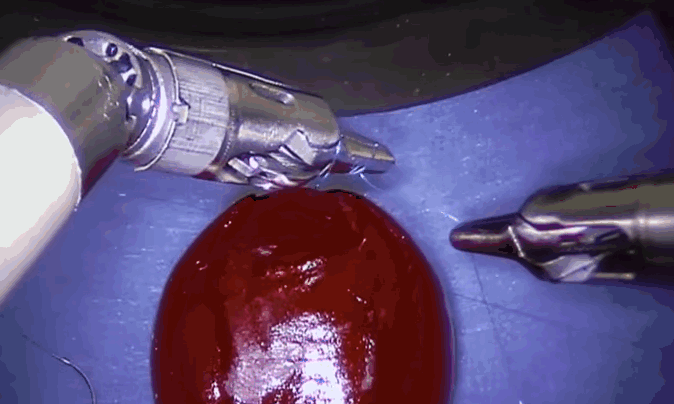
A daVinci Robotic System stitches a grape with extreme precision. Source: Youtube. Credits: Intuitive Surgical. Authorized reuse
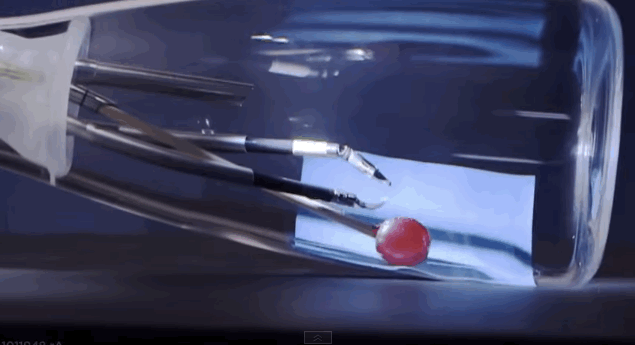
The robotic arms usually operate in very small area, decrease surgery invasivity. Source: Youtube. Credits: Intuitive Surgical. Authorized reuse
The expert presented a case of a patient that underwent emergency surgery because an intestinal loop got attached to the intraperitoneal mesh and then got perforated years after the first surgery. Using intraperitoenal meshes is not a really good idea: the ideal space to set a mesh is retromuscolar, between muscle and peritoneum, to avoid contact with abdominal content. On the other hand, the only way to place a retromuscolar mesh is doing an open surgery. The question is: choosing an open surgery with large incision, increased complication rate, increased hospitalization time or doing a not-less risky procedure like placing an intraperitoneal mesh with a laparoscopic procedure but with improved outcomes?
There is not an easy answer and every approach is tailored on the patient itself. Anyway, both procedure has own limits and there is no consensus on which procedure is the best among surgeons. However, that's what robotic surgery is for. Thanks to minimally invasive approach and higher mobility of robotic arms, robotic surgery can place a retromuscolar mesh (blue - sublay, in the figure) with an extraperitoneal access. This means the entire surgery will take place without entering really into the abdomen cavity but inside a virtual space created between peritoneum and muscles. In other words, we will have the efficiency of retromuscolar meshes along with all advantages of laparoscopic surgery (minimally invasive approach). This is a concrete example on how this new technology will solve issues in general surgery. There is still a lot of room for science-fiction things that will become real. In another conference room where the main topic were "New technologies", there was a discussion about the use of Indocianine Green (ICG): a contrast agent that can revel hidden blood vessels, biliary ducts and lymphatic vessels, enhancing the surgeon vision. This technology is already available: surgeon can switch to normal color mode to ICG vision to verify if there are blood or bile leaks and to verify the extension of resection for cancers. There will be also new displays for surgeons: 4k and 8k technologies for surgery will be soon available for laparoscopic procedures.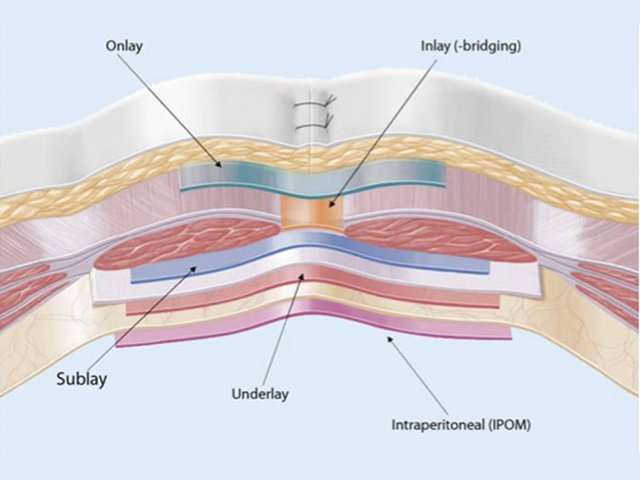
Scheme for mesh placement for ventral hernia. Credits: Muysoms F et al. See Bibliography. CC BY 3.0
The future still has to come 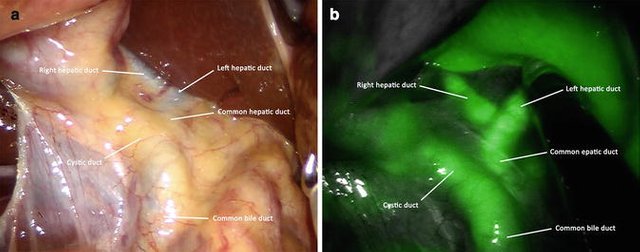
An image from a daVinci indocyanine green (ICG) near infrared (NIR) fluorescence Imaging Vision System. Credits: Intuitive Surgical. Authorized reuse.
But more than these images, the most amazing thing I have ever seen at this meeting was this animated image of the next daVinci surgical system: the daVinci SP (Single Port). This next generation robotic system will allow to have a full set of flexible robotic arms with just one small skin incision.
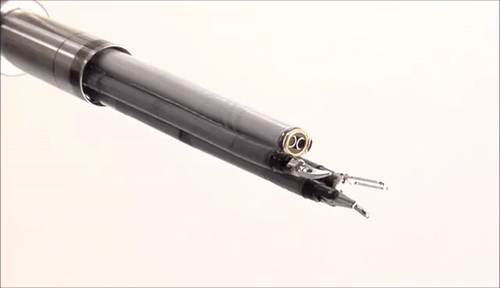
A detail of the new generation daVinci SP Surgical System with flexible robotic arms. Source: YouTube. Credits: Intuitive Surgical. Authorized reuse.
One last thing to say is how these robotic arms are controlled: remotely. This means that one day we could have a surgeon managing a surgery from the other side of the world!
Welcome to the future!
| Bibliography |
|---|
- Gosrisirikul C. et al.New era of robotic surgical systems. Asian J Endosc Surg. 2018 Oct 10. doi: 10.1111/ases.12660
- Muysoms F et al. EuraHS: the development of an international online platform for registration and outcome measurement of ventral abdominal wall hernia repair. Hernia. 2012 Jun;16(3):239-50. doi: 10.1007/s10029-012-0912-7. Epub 2012 Apr 18
- Matanes E et al. Robotic laparoendoscopic single-site surgery in gynecology: A systematic review. Eur J Obstet Gynecol Reprod Biol. 2018 Oct 3;231:1-7. doi: 10.1016/j.ejogrb.2018.10.006
- Maker AV et al.A Technique to Define Extrahepatic Biliary Anatomy Using Robotic Near-Infrared Fluorescent Cholangiography.J Gastrointest Surg. 2017 Nov;21(11):1961-1962. doi: 10.1007/s11605-017-3455-5. Epub 2017 Jun 5.
- Kassite I et al.A systematic review of the learning curve in robotic surgery: range and heterogeneity.Surg Endosc. 2018 Sep 28. doi: 10.1007/s00464-018-6473-9.
- Intuitive Surgical 2017 Annual Report.
All images and videos representing daVinci surgical system are owned by Intuitive Surgical Inc. and their use was authorized for the purpose of this text

Join the greatest scientific community on Steemit! Visti che @steemstem discord here!
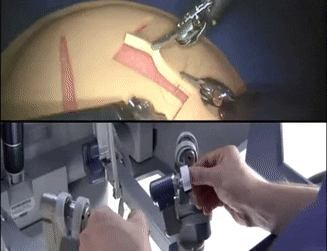
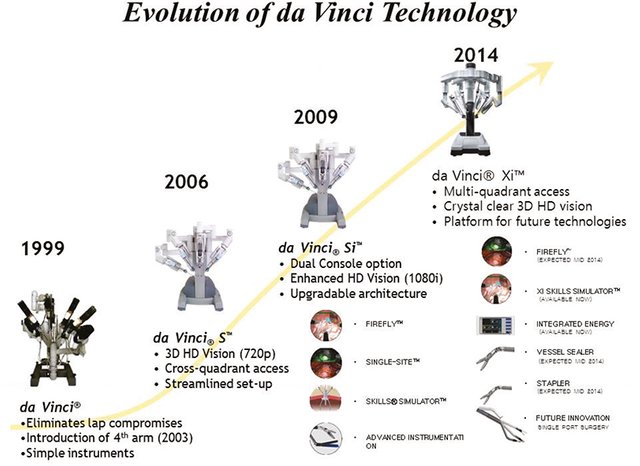
The new DaVinci single port looks like it was taken from a sci-fi movie, the control is unbelievable, it will ease a lot of complicated operations, simply wonderful! Still, even with robotic surgery, I don't think intraperitoneal meshes are a good idea ! The long-term complications such as adhesion or fistulation are too frequent , people with low life expectancy are best suited for this procedure but that's just my humble opinion, you're the expert here ! Amazing article by the way Dr !
Thanks a lot! Intraperitoneal mesh are nowdays made in a special materials that should avoid intestinal fistula, still there is a small chance it could happen. Laparoscopic is just more safe than open surgery that's why a lot of surgeons use that meshes. Robotic approach will change everything!
I see, that sounds promising ! I like discovering the latest technology, you should do it more often :)
Hi, if you would like to join the English Premier league contest, Click here - https://steemit.com/giveaway/@jmehta/round-9-round-1-premier-league-predictions :)
Very interesting information. I love medicine and science in general so much, thanks for sharing.
Thanks for reading my post!
This post has been voted on by the SteemSTEM curation team and voting trail in collaboration with @utopian-io and @curie.
If you appreciate the work we are doing then consider voting all three projects for witness by selecting stem.witness, utopian-io and curie!
For additional information please join us on the SteemSTEM discord and to get to know the rest of the community!
Hi @cryptoitaly!
Your post was upvoted by utopian.io in cooperation with @steemstem - supporting knowledge, innovation and technological advancement on the Steem Blockchain.
Contribute to Open Source with utopian.io
Learn how to contribute on our website and join the new open source economy.
Want to chat? Join the Utopian Community on Discord https://discord.gg/h52nFrV
Future of surgery is just behind us. I can't believe that the robotic surgery combined both the open surgery and the laparoscopic surgery while doing away with the limitation of both. I was a bit taken aback when i read that its application was limited but was later releaved when i read this.
I want to assume that with its application in gynecologic surgery, it would be useful in improving how ceaserian section is performed in open surgery.
daVinci technology in robotic surgery has really helped to move medicine forward.
Then don't you think that with the above, less surgeons will be needed in the future?
Thanks for this piece doc @cryptoitaly.
No!
First, there will be still need of 1 man (1 surgeon) to operate such technological device. The remote thing will be useful because there are some very rare pathologies and surgeons usually specialize in just one of them. There is no real "general surgery" but surgeons that get specialized on upper gastrointestinal tract, biliary surgery, abdomen wall surgery etc. Best thing is that a very skilled and highly specialized surgeon from Europe would do surgery on an American patient without taking a flight!
That is a good news to hear.
Congratulations @cryptoitaly! You have completed the following achievement on the Steem blockchain and have been rewarded with new badge(s) :
Click on the badge to view your Board of Honor.
If you no longer want to receive notifications, reply to this comment with the word
STOPDo not miss the last post from @steemitboard:
Hi @cryptoitaly!
Your post was upvoted by @steem-ua, new Steem dApp, using UserAuthority for algorithmic post curation!
Your UA account score is currently 1.703 which ranks you at #31958 across all Steem accounts.
Your rank has dropped 270 places in the last three days (old rank 31688).
In our last Algorithmic Curation Round, consisting of 270 contributions, your post is ranked at #128.
Evaluation of your UA score:
Feel free to join our @steem-ua Discord server